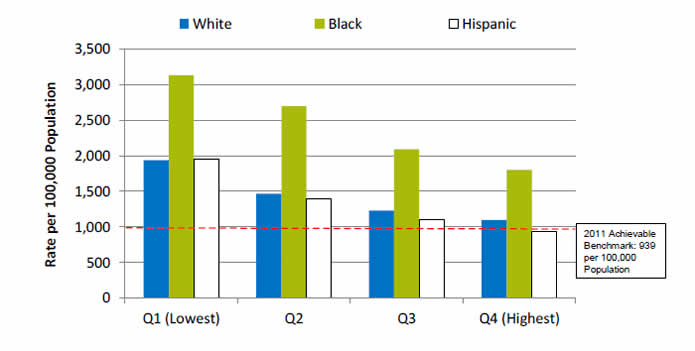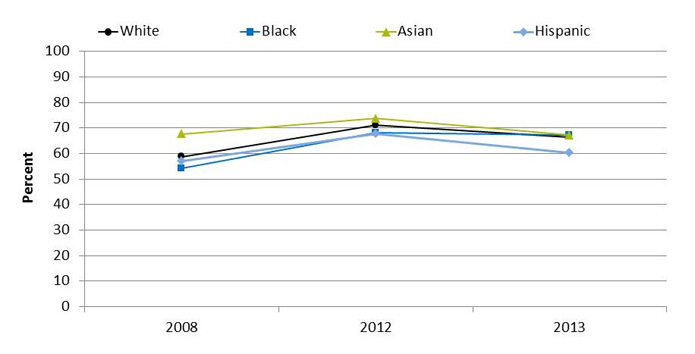NQS Priority: Care Coordination
Potentially Avoidable Hospitalizations
Potentially avoidable hospitalizations, by race/ethnicity, stratified by area income, 2012

| Income | White | Black | Hispanic |
|---|---|---|---|
| Q1 (Lowest) | 1936 | 3131.3 | 1945.9 |
| Q2 | 1464.9 | 2694.8 | 1390.9 |
| Q3 | 1226.7 | 2091.6 | 1104.1 |
| Q4 (Highest) | 1096.5 | 1800.3 | 932 |
2011 Achievable Benchmark: 939 per 100,000 Population.
Source: Agency for Healthcare Research and Quality (AHRQ), Healthcare Cost and Utilization Project, State Inpatient Databases, 2012 disparities analysis file, 2012 quality analysis files, and AHRQ Quality Indicators, modified version 4.4.
- Groups With Disparities: In 2012, in all income groups, rates of potentially avoidable hospitalizations for all conditions were higher for Blacks than Whites.
- Achievable Benchmark:
- In 2011, the top 4 State achievable benchmark for all potentially avoidable hospitalizations was 939 per 100,000 population. The States that contributed to the achievable benchmark are Hawaii, Oregon, Utah, and Washington.
- The overall achievable benchmark could not be attained for 13 years.
- Hispanics in the highest income quartile have already achieved the benchmark.
Importance of Getting Information Electronically
Patients who reported that it was important for them to get their own medical information electronically, by race/ethnicity, 2008-2013

| Race/Ethnicity | 2008 | 2012 | 2013 |
|---|---|---|---|
| White | 58.8 | 71.1 | 66.4 |
| Black | 54.1 | 68.1 | 67.2 |
| Asian | 67.6 | 73.8 | 67.2 |
| Hispanic | 57.1 | 67.6 | 60.2 |
Source: Health Information National Trends Survey. Iterations included in this table are; HINTS 3, HINTS 4 Cycle 1, and HINTS 4 Cycle 2. Available at http://hints.cancer.gov.
- Trends:
- From 2008 to 2013, the percentage of Hispanic patients who reported that it was very important to be able to get their medical information electronically increased from 57.1% to 60.2%, the percentage for Black patients increased from 54.1% to 67.2%, and the percentage for White patients increased from 58.8% to 66.4%.
- Groups With Disparities:
- In 2013, Hispanic patients were less likely than White, Black, and Asian patients to report that it was very important to be able to get their medical information electronically.
AHRQ Health Care Innovations in Care Coordination
- Location: Springfield, Massachusetts.
- Population: Predominantly Latino patients with chronic illnesses and disabilities.
- Intervention: With funding from a per capita payment system, nurses at this community-based primary care clinic provide culturally competent care coordination.
- Outcomes: Improved the provision of recommended care processes, reduced health care costs, and enhanced self-management capabilities.
Return to National Quality Strategy Priorities
Return to Contents



